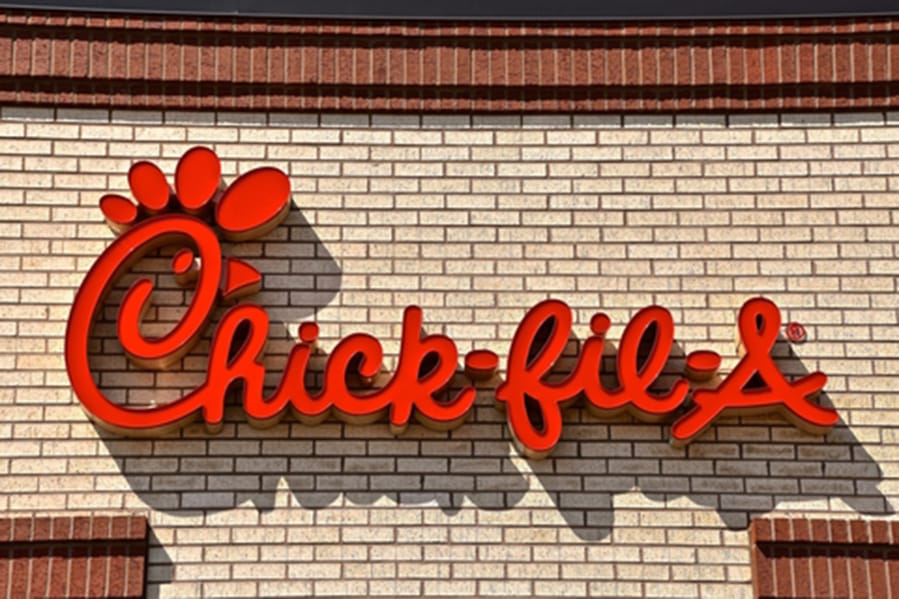Through the diligent efforts of those billboard cows with their poor penmanship and dubious spelling skills, Chick-fil-A has moved up the ranks from the seventh-largest restaurant chain in the United States to become the third.
The chicken sandwich giant blew past Wendy’s, Burger King, Taco Bell and Subway on its ascent, with $10.46 billion in American store sales, according to Nation’s Restaurant News’ latest countdown. Up 17 percent for the year, Chick-fil-A stands behind only McDonald’s ($38.52 billion in American sales) and Starbucks ($20.49 billion).
Average sales for a Chick-fil-A location brought in $4.6 million in 2018, up from $4.2 million in 2017 — more than three times that of major chicken competitor KFC.
David Portalatin, food industry expert for Chicago-based market research NPD Group, said Chick-fil-A’s ascent is more noticeable because everyone else is treading water.
Chick-fil-A announced June 17 it is opening a second Vancouver location near Vancouver Mall.
“The industry as a whole is very flat,” Portalatin says. “It’s all about demographics, where our population is shifting, from a life-stage perspective. Where total restaurant traffic increased less than 1 percent, Chick-fil-A saw double-digit growth.”
Aging boomers are eating out less often, and while millennials rely on restaurants more than any other group (240 restaurant meals per capita per year, compared with 185 in the general population), they are still eating out less than Generation X did at their age.
The company is not without challenges, from its faith-based decision to remain closed on Sundays (making things problematic for locations in airports and sports stadiums) to its management’s statements in opposition to same-sex marriage, which prompted boycotts and “kiss ins” organized by GLAAD. But there are reasons the American Customer Satisfaction Index has rated it the No. 1 company for the past four years.
First, for each of the nearly 100 new franchises opened each year since 2003, the parking lot fills up with tents and there’s a sanctioned overnight “First 100 Campout” that rewards the first 100 customers through the door the next morning with Chick-fil-A for a year (technically, you get a card loaded with 52 No. 1 meals, which is a chicken sandwich, medium waffle fries and a medium beverage).
And second, those waffle fries. The No. 1 ordered item on the short menu, these skin-on spuds are from Washington state, a medium order ringing in at 360 calories. Fried in canola oil, their distinctive shape have set it apart from other fast-food restaurants since the chain debuted in 1967.
Portalatin says that industry experts agree that the biggest distinguishing feature for Chick-fil-A is the customer experience.
“The level of customer satisfaction is highly differentiated from many of their fast-food peers.”
Chick-fil-A’s customer service is legendary, prompting rafts of memes enumerating real and imagined over-the-top polite employee interactions.
Global restaurant consultant Aaron Allen says some of this is about the speed of the drive-through and a culture of saying “please” and “thank you.” Some of the positive customer-service experience can be linked to an embrace of technology. In 2016, the chain debuted what it called Mom’s Valet (which let parents order at the drive-through, then go inside where a Chick-fil-A employee would have a table ready). More recently, the company launched a successful app, and it is routine for employees to walk the drive-through line taking tablet orders to expedite.
Allen says he thinks that some of the brand’s success is about how it has grown:
“There are a couple of paths to growth. You can cherry-pick markets like Shake Shack. Or you can grow in concentric circles like Chick-fil-A. Then you’re gaining economies of scale in terms of market share saturation, and your supply chain can grow with you.”
While he thinks the company has grown at a sustainable, measured pace, Allen sees substantial prospects in Chick-fil-A’s future. The company opened its first New York City restaurant in 2015 and has rapidly expanded there. Plus, international markets have been eager to acquire the brand.
“Half of all meals are now eaten in restaurants, half of those as fast food, and half of those are just 10 companies. Chick-fil-A is now one of them,” Allen says.



